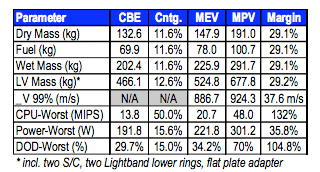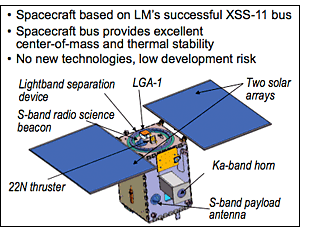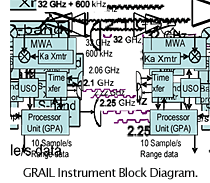Spacecraft
The GRAIL spacecraft design and their components are derived
from LM XSS-11 spacecraft heritage. A single-string architecture meets this
short mission's reliability requirements.

The
resulting design meets all the GRAIL mission and science requirements with
ample technical margins that provide flexibility to solve problems that may
arise during development and which meet or exceed design principles established
by the Jet Propulsion Laboratory (JPL; see Table to right).
Each spacecraft
bus is a rectangular composite structure. The science payload ranging antennas
are in thermal enclosures and are mounted so that they are nominally on the
line between the two spacecraft’s center of masses. The other components
of the payload instrument are on a single interior bus panel for easy integration
and test.

There are 2 non-articulated solar arrays of XSS-11 heritage that are deployed
just after separation from the LV. Warm gas systems identical to XSS-11 provide
V for maneuvers and unloading of the 3 reaction wheels. Additional attitude
sensing components include an IMU, sun sensor and star tracker.
The C&DH, power management, and lithium ion battery are also XSS-11
heritage. The S-band telecommunications system for communication with the
DSN uses heritage components (Themis and Genesis).
The spacecraft will be built, the science payload integrated and the systems
tested at LM's Denver facility. LM will use two system-level spacecraft
test labs (STL) and one software simulator (SoftSim) testbed with unlimited
copies that enable integration and verification of all hardware and software
throughout the Assembly Test and Launch Operations (ATLO) cycle.
Payload

To measure the inter-spacecraft range-rate, each spacecraft has a Ka-band
Lunar Gravity Ranging System (LGRS) derived from the GRACE instrument.
The elements of the LGRS are shown to the right.
LGRS performance verification will be done at the JPL Gravity Recovery
Instrument for Planets (GRIP) testbed that has X-level per-formance verification
capability and sub-X adjustability in an 18-m anechoic chamber.